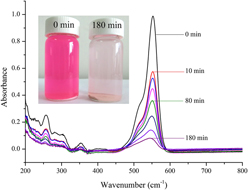Crossref Citations
This article has been cited by the following publications. This list is generated based on data provided by
Crossref.
Chong, Shan
Zhang, Guangming
Wei, Zhongheng
Zhang, Nan
Huang, Ting
and
Liu, Yucan
2017.
Sonocatalytic degradation of diclofenac with FeCeOx particles in water.
Ultrasonics Sonochemistry,
Vol. 34,
Issue. ,
p.
418.
Wang, Meng
Peng, Zhijian
Li, Hong
Zhao, Zengying
and
Fu, Xiuli
2018.
C fibers@MoO2 nanoparticles core–shell composite: Highly efficient solar-driven photocatalyst.
Journal of Materials Research,
Vol. 33,
Issue. 6,
p.
685.
Xiao, Yifei
Jin, Xue
Zhang, Li
Luo, Huan
and
Li, Junfeng
2018.
Preparation and photocatalytic performance of Cu-doped CeO2 by citrate combustion method.
Integrated Ferroelectrics,
Vol. 191,
Issue. 1,
p.
169.
da S. Pereira, Wyllamanney
Gozzo, Cipriano B.
Longo, Elson
Leite, Edson R.
and
Sczancoski, Júlio C.
2019.
Investigation on the photocatalytic performance of Ag4P2O7 microcrystals for the degradation of organic pollutants.
Applied Surface Science,
Vol. 493,
Issue. ,
p.
1195.
Lin, Yi-Hsuan
Shen, Li-Jiuan
Chou, Tzu-Ho
and
Shih, Yang-hsin
2021.
Synthesis, Stability, and Cytotoxicity of Novel Cerium Oxide Nanoparticles for Biomedical Applications.
Journal of Cluster Science,
Vol. 32,
Issue. 2,
p.
405.
Dayanidhi, Kalaivani
and
Sheik Eusuff, Noorjahan
2021.
Sonocatalytic performance of eggshells loaded with transition metal ions for decolorization of crystal violet dye.
Materials Research Bulletin,
Vol. 138,
Issue. ,
p.
111201.
Mužina, Katarina
Kurajica, Stanislav
Guggenberger, Patrick
Duplančić, Marina
and
Dražić, Goran
2022.
Catalytic activity and properties of copper-doped ceria nanocatalyst for VOCs oxidation.
Journal of Materials Research,
Vol. 37,
Issue. 11,
p.
1929.
Saravanan, K
Ilayaraja, M.
Muthukrishnan, P.
Ananthakrishnan, S.
and
Ravichandiran, P.
2022.
Green synthesis and characterization of Ag and Ag/Fe3O4 nanocomposites for antimicrobial effect and rhodamine- B dye degradation.
Journal of the Indian Chemical Society,
Vol. 99,
Issue. 8,
p.
100575.
Shafqat, Rabia
Begum, Robina
Irfan, Ahmad
and
Farooqi, Zahoor H.
2023.
Hydroxyapatite stabilized silver nanoparticles and their catalytic activity.
Zeitschrift für Physikalische Chemie,
Vol. 237,
Issue. 7,
p.
981.
Ali Al Saidi, Abdullah Khamis
Ghazanfari, Adibehalsadat
Baek, Ahrum
Tegafaw, Tirusew
Ahmad, Mohammad Yaseen
Zhao, Dejun
Liu, Ying
Yang, Ji-ung
Park, Ji Ae
Yang, Byeong Woo
Chae, Kwon Seok
Nam, Sung-Wook
Chang, Yongmin
and
Lee, Gang Ho
2024.
Ultrasmall cerium oxide nanoparticles as highly sensitive X-ray contrast agents and their antioxidant effect.
RSC Advances,
Vol. 14,
Issue. 6,
p.
3647.
El-Sabban, Heba A.
Mady, Amr Hussein
Diab, M.A.
Zoubi, Wail Al
Kang, Jee-Hyun
and
Ko, Y.G.
2025.
Novel environmentally-friendly 0D/3D TiO2@FeMoO4 binary composite with boosted photocatalytic performance: Structural analysis and Z-scheme interpretations.
Journal of Alloys and Compounds,
Vol. 1010,
Issue. ,
p.
177265.
